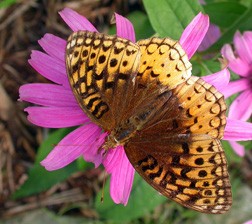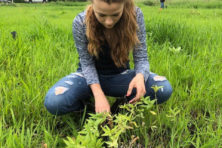Know Your Butterflies
- Share
- Tweet
- Pin
- Share
Few animals are as gentle, harmless, common and beautiful as butterflies. The various species I have photographed during the past 50-plus years have continually proven to me that they rank among the world’s most fascinating creatures.
I’m convinced that cultivating in youngsters admiration and respect for butterflies and other small creatures helps them become more appreciating and sensitive adults. Could you imagine the requirements for high school graduation including the recognition of 25 species of butterflies, their caterpillars and host plants? Could you possibly expect our present representatives in high government offices to approve this concept? I can’t either!
However, these young people will be in the “driver’s seat” as far as caring for their environment someday, and they might as well know something about it. Why not begin at the bottom for a change, and learn the basics such as the birds, trees, flowers, ferns and butterflies that exist in their own counties or yards? How downright wonderful it would be if today’s children would know as much about butterflies as they do about computers!

A great Spangled Fritillary Butterfly enjoys a flower in the Lukes’ garden.
Here are eight common butterflies as a starter. Everyone knows the Monarch, strong leisurely flier, renowned for its long annual migration. What you may not know is how easy it is to identify the sex of these well-known insects. One of the black veins on the underside of each of the male’s hind wings contains an enlarged black spot. In reality these are tiny pockets containing scent scales that the male can brush into the air in order to attract females.
The Viceroy is quite similar to the Monarch but about three-fourths of an inch smaller in width. Look carefully at the hind wings of the Viceroy. A black vein running parallel to the back edge of each hind wing cuts across the several black veins leading toward the edge. The Monarch lacks this easily seen black vein. Viceroys are on the wing right now. You will also notice that they are considerably faster fliers than the larger Monarchs.
A close relative to the Viceroy is one of my favorites, the White Admiral. More than once in the past I’ve tried unsuccessfully to photograph one as it fed on the nectar of a Purple Coneflower in our butterfly garden. This is a black butterfly with white bands on its wings. A row of red spots and blue borders decorates each hind wing. They are exceptionally beautiful fliers and frequently soar with their wings held horizontally. These classy butterflies are known to favor certain perches and will use them over and over. Their weird-looking caterpillars (larvae) eat the leaves of Birch, Poplar and Willow.
If there is one good reason I allow a small patch of stinging nettles to grow behind our watering tank at the garden, it’s because these tall, to-be-respected plants are favored by the larvae of the Red Admirals. They also like Hops and Thistles. One can hardly mistake this showy butterfly species – dark brown body with bright orange wing stripes. Some of these butterflies survive the winter as adults and surprise us on sunny days during the spring maple syrup season when snow lingers in the woods.

The Northern Pearly Eye is one of the few butterflies found in the woods in midsummer.
One of my very favorite late-summer butterflies always reminds me of my high school days and “Purple and Gold Kewaunee!” I happen to greatly admire the Swamp Thistle and frequently see the gaudy gold-colored Great Spangled Fritillary getting nectar from the brilliant purple flowers. They are strong, fast fliers but are attracted to flower nectar and often stop to feed. Fortunately, their larvae eat the leaves of one of our most common plants, violets.
The yellow and black Canadian Tiger Swallowtails had a rather poor summer, as reflected by the relatively few I have seen thus far. The little tail-like extensions and blue-and-red rear wing markings make this one of the most colorful species in this region. The caterpillars of this rather variable butterfly favor leaves of Quaking Aspen, Willows and Birch trees in eastern Wisconsin.
Too many people automatically lump all sulphur butterflies with the harmful European Cabbage Whites, when in reality the Common Sulphur is harmless and very attractive. The so-called “puddling” of dozens of them on the ground can be quite awesome. Perhaps it was this species, or one like it, that led to the name “butterfly.” An old belief held that butterflies stole milk and butter, and hence attained their color. Caterpillars of the Common Sulphur feed mainly on clover.
A small rather inconspicuous butterfly of mid-summer, the Northern Pearly Eye, could serve as a good example for the saying of a Danish entomologist of the late 18th century, Johann Fabricius. He said, “Natura maxime miranda in minimis,” which means, nature is most to be admired in those works which are least. These butterflies are attracted to grape jelly put in the orange halves set on the feeders for Orioles and other birds.
The Northern Pearly Eye’s soft brown color is highlighted with tiny eyespots. Try to catch one of these butterflies whose flight, usually near the ground, appears to be weak and jerky and you are in for a surprise. Suddenly it will dance and bob and weave its way through the shrubs and tall grass, easily escaping your most energetic attempts to capture it with your butterfly net.

Sweet grape jelly in the orange lures many Northern Pearly Eyes to the bird feeder.
When at rest its brighter colored rear wings are sometimes folded between the less conspicuous forewings. Its small one-jointed front legs are frequently held against the thorax and not seen. Food for the tapered light green caterpillars could not be more common and abundant – grasses and sedges. Hopefully these pleasant butterflies, whose homes are the sunlit trails and open spaces in woods, will be with us for many years ago come.
Prepare to sharpen your powers of observation, to learn more about the native plants many butterflies prefer and need, absorb and enjoy new and exciting experiences and to feel ever increasingly that you are a genuine partner in nature with other creatures large and small. By all means, take small children by the hands and lead them into the great outdoors to learn about the butterflies.

